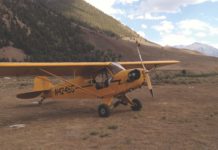
By Thomas P. Turner
We learn early in our flying career that proper load distribution is vital to safely flying an airplane. Then we make weight-and-balance calculations for and fly in trainer airplanes in configurations where center of gravity (CG) distribution is rarely a factor. For instance, I completed part of my Private certificate training in a large university flight program, and I cant remember ever being asked to compute weight and balance in a configuration that put CG out of tolerance, or learning that CG often shifts in flight with fuel burn so a landing configuration calculation is at least as important as verifying CG position for takeoff. From years of teaching certificated pilots of all experience levels I conclude that my early experience is widespread-it seems few pilots diligently compute CG locations for takeoff and landing. Fewer still understand the effects of CG positions within, but near the extremes, of the center-of-gravity envelope.
When was the last time you did a weight-and-balance calculation? If youre like many pilots, it may have been on your last checkride. What effect does CG location have on aircraft control and performance, within and outside the envelope? And how can those effects be used to our advantage while remaining within the envelope?
Stability and Control
To maneuver an airplane within its design capabilities, it needs to be stable. Stability is that characteristic that causes an airplane to continue in a desired flight attitude without needing massive pilot intervention-it trims up nicely-and for the aircraft to tend to return to its desired attitude if disturbed by turbulence or an unintended control input. Stability in large part results in what pilots perceive as control feel. Control feel is quite subjective-some pilots like an airplane that is light on the controls for greater maneuverability. Others prefer a more stable feel for instrument flight. The stable camp thinks sporty airplanes are squirrelly, while the sporty pilots say stable airplanes fly like a truck. You say potato….
Control authority is another vital function of a properly loaded airplane.Control authority is the ability to overcome stability with control inputs.An airplane with limited control authority may not be able to develop sufficient aerodynamic force with its control surfaces to divert the airplane from its flight attitude. If control authority is too great, it may be difficult to avoid deflecting the airplane off its flight path with even a very light touch on the controls. A successful airplane design is be a compromise of stability and control authority. And both characteristics are directly affected by location of the center of gravity.
CGs Effect
In most cases, an airplane pivots in space around its center of gravity. The further forward the CG is located along the airplanes longitudinal axis, the more fuselage and tail area there is behind the CG to weathervane the airplane into its flight path when disturbed. This positive stability is what makes the airplane stable; the further forward the CG, the more stable the airplane becomes. Conversely, as the CG moves rearward theres less fuselage and tail located aft of the center of gravity, and less tendency to weathervane itself out of pitch and yaw excursions when deflected. Put another way, placing CG further forward means more stability. Place the CG further aft, and the airplane becomes less stable.
Simple physics tells us the elevators effectiveness is enhanced when there is a greater leverage, or arm, between the CG and the elevators. A little downward or upward force on a long lever has the same effectiveness as a lot of force on a shorter lever, and the lever is the fuselage aft of the center of gravity.
Of course, we can have too much of a good thing. If the CG is too far forward the airplane may be so stable it is unmaneuverable, or there may not be enough control authority to provide sufficient force to overcome the airplanes tendency to pitch downward. If the CG is too far aft the airplane may be so unstable, with limited control authority, as to be uncontrollable.Each airplane design will have a defined range of CG travel, then, that results in a combination of stability and control authority that permits safe flight and the attainment of Pilots Operating Handbook (POH) performance.This is the airplanes center of gravity envelope.
Theres another variable in play as well. Pitch control is a balancing act between the wings push upward and the horizontal stabilizers countering push downward. As the center of gravity is moved forward of the center of pressure (also the called the center of lift), the nose will tend to pitch the wing downward. It takes a higher angle of attack to maintain level flight; this in turn requires greater up-elevator to compensate. Its quite possible that, given a far enough forward CG, that there is not enough elevator and trim authority to hold the nose up without excessive drag.
Some airplane types may flirt with regimes where there is neutral or weak upward force on the horizontal stabilizer, and canard-type airplanes have two lifting surfaces (wing and forward stabilizer). These airplanes, not coincidentally, tend to enjoy wide center of gravity envelopes.
Always in Motion
An airplanes CG location is rarely static. As fuel burns or is transferred from one tank to another, the CG location will shift. Retractable landing gear geometry may move the CG forward or aft as the wheels move up or down.Flap position can create effects similar to moving the CG fore or aft.
In most light planes, the shift is rearward with fuel burn. Its possible, then, to load an airplane within the center of gravity envelope for takeoff, only to have it move out of the envelope during flight. This can set up the pilot for a dangerous landing attempt. Aft CGs are most common after fuel burn, and most critical because the airplane will tend to pitch up. This is especially true as the plane is slowed for landing, when less airflow over the elevator may mean the pilot gets to the point even full down elevator wont overpower the nose-up tendency. Out-of-CG mishaps tend to end with a stall just short of the runway, where the plane was being slowed for the flare.
The Edges of the Envelope
Theres something important the POH doesnt tell us: Although we may have a wide CG range, airplane performance and handling will be significantly different as loading approaches one edge or the other of the authorized envelope. An airplane loaded near the forward edge of its CG limits will tend to pitch nose-down. It will be very stable, riding well in turbulence. As itll need additional airflow over the elevator to resist the tendency to pitch down, it will take more elevator force to increase its pitch attitude.This creates extra drag, slowing forward speed or requiring more power (and more fuel) to achieve a given speed.
A CG-forward airplane will also need more speed for control authority-and therefore more runway-to take off. For a given climb attitude, therell be more drag, so climb performance will suffer. On landing, the nose-down tendency will make it more difficult to flare…especially if the pilot lets the airspeed (already aggravated by higher drag) get too low. At initially slow go-around speeds there may not be enough elevator effectiveness to turn a descent into a climb.
By now you should have figured out that an airplane near its aft CG limit will be very unstable. It will wobble around, requiring active pilot control.Itll trim out at a faster airspeed in cruise-youll need to trim nose down, reducing induced drag-but it may be so squirrelly that you cant control it in turbulence at all. An aft-CG condition will attempt to pitch up toward a stall on landing. The slower you get on final approach, the more elevator deflection itll take to hold attitude. Worse, as the airspeed decays and the nose-high pitch tendency increases, there will be less elevator authority available to fight it. The unstable aircraft can easily fly itself-and you-right into a stall. A go-around will likely require a lot of finesse to fly safely.
Whether fore or aft, once outside the approved CG envelope all bets are off as to whether the airplane can be flown safely and predictably.Tendencies found near the extremes of CG loading will be exaggerated once the boundary is crossed. An aircraft loaded forward of its CG limits may nose down excessively; one loaded aft-of-limits can enter an unrecoverable flat spin. Worst of all, you wont know if a given condition is flyable until youve committed yourself (and any passengers) to flight.
Defining the Envelope
Its common practice for manufacturers to establish the aft center of gravity limit at a point that is within one inch of the rearmost point that allows normal recovery from a one-turn spin, when the airplane is certified in the Normal category. Utility category airplanes typically have the aft limit set several inches further forward, which is why airplanes are approved for intentional spins when loaded within Utility limits, but are not approved for spins when aft seat passengers or baggage place the airplane in the Normal category. In general, rearward CG limits are defined by stability issues, while forward CG limits are set based on their effect on control authority.
Also With This Article
“Flaps And CG”
“Check CG”
“Multiengine Performance”
“Taking Advantage of CG”
“Forward CG Effects”
“Emergency Out-of-C.G. Landing”
-Tom Turner is a CFII-MEI who frequently writes and lectures on aviation safety.



